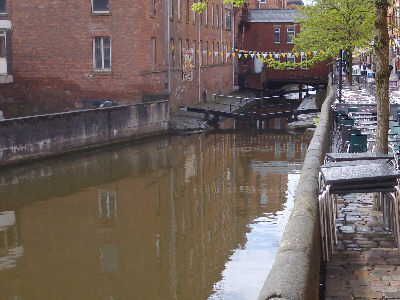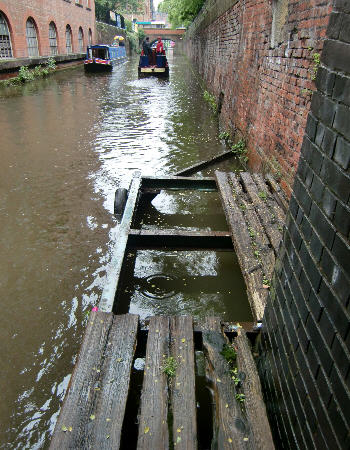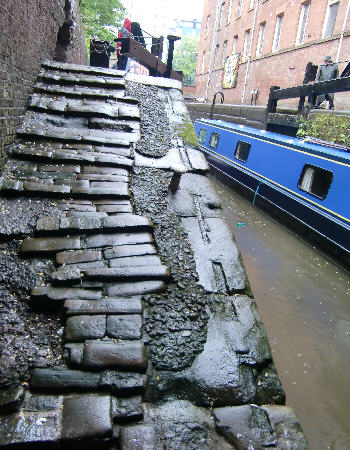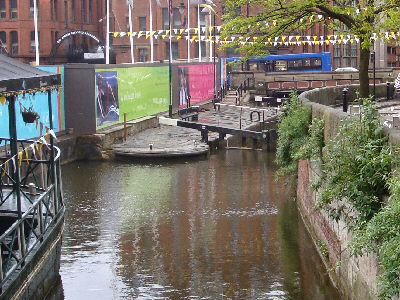[Link to News from January to April 2009] [Link to News from May to August 2009]
June 12th 2009
Following a wave of protests that the safety fence planned for Canal Street in Manchester will block access to Lock 86, British Waterways has announced a package of safety measures.
Boaters were concerned that the new fence would make the use of Lock 86 on the Rochdale Canal more hazardous if foot access to the lock is stopped. Some had expressed concern that BW was not looking after the interests of boaters in this case.
Read about the plans for the fence here.
BW to improve safety at lock

A new landing is to be added on the offside above Lock 86
BW has now responded to the criticisms by saying that there was always an intention to make improvements to Lock 86 to make it safer to operate when the only access is by boat.
The planned additional safety measures are:
• the offside landing above the lock to be extended by adding a new landing stage (possibly floating)
• the existing landing stage below the lock (under the bridge) to be re-surfaced to improve safety
• bespoke steps to be added to the steep cobbled slope between the lock side and the lower landing stage
These measures will "design out" the need for boaters to climb over the wall and use the traditional steps, which BW now considers unsafe.
BW hopes to have the new features in place before the Mardi Gras festival in late August, which has caused access problems in the past.
However, if the new fence is erected before the lock upgrades are completed, then the access gate to the steps will be left open until the new measures are in place.

This landing below Lock 86 is to be improved. Photo: Alan Platt

Steps are to be added to this steep ramp from the landing below Lock 86. Photo: Alan Platt
In a reply to the concerns expressed by IWA's Machester Branch, Debbie Lumb, General Manager of BW's North West Waterways, commented: "It is true that this is not explained very well in the planning documents and in hindsight could have been added. However, please understand that we have always been the voice of our customers - both in boating circles and in horseboating - throughout this process. We are simply guilty of not telling everyone everything we were doing outside of this planning application!"
What about Lock 87?

Lock 87 needs a new offside landing stage, too.
The new safety measures at Lock 86 highlight the need for a new landing above Lock 87.
Like Lock 86, this has only a short area where boat crews can step aground and there are the same concerns over the difficulty of getting off the bow of certain types of boats.
At the moment crew members are able to walk down from Lock 86 to prepare the lock but, with the fence in place and the traditional steps out of use, all crew members would in future be aboard their boats, hence the need for an extended landing at Lock 87.
BW's Debbie Lumb admitted that a new landing at Lock 87 was not planned at the moment, but will look into whether there may be cost savings in doing the works at the same time as Lock 86. However, BW's limited budgets may mean that this needs to wait.
Who pays?
Some boaters, hearing about the proposed lock improvements, are now asking who should pay for them. They say the cost of these additions should be included in the total costings for the fence and not be an additional burden on cash-strapped BW.
It can be argued that, since the need for these added measures has arisen because of the planned fence, the budget for the fence should include the lock improvements and planning approval should be made only on the condition that it does.
Will this solve all the problems?
The improvements to Lock 86 go a long way to address the issues raised by boaters. However, some have pointed out that access by foot will sometimes required in order to let water down when the pound below the lock is low.
Boats sometimes come to a halt in this pound if the level is down, often due to grounding on objects that have been thrown into the canal. If a boat leaves the lock when the level is low, there is the risk of damaging the upper wooden cill behind the top gates. A crew member going ahead to run some water down can prevent this.
So, what would happen in future, when boaters cannot reach Lock 86 on foot, with all the crew members on board the boat aground in the middle of the canal? Presumably they would have to call BW staff out to sort a problem which most crews could have sorted for themselves.
Concerns are being raised about the fence preventing assistance being given in the event of an emergency. Suggested scenarios include a legitimate canal user falling into the water and getting into difficulty or the possibility of a boat getting caught on the cill and sinking. People on the street would be unable to offer assistance as they would be unable to climb over the fence. Another scenario suggested is of a boater suffering a serious injury and paramedics being unable to reach them. One correspondent asks whether BW has made a risk assessment in relation to creating a place to which there is no access other than by boat.
BW has said that if the new fence is erected before the lock improvements have been carried out at Lock 86, then the access gate to the steps will be left open until that has happened. However, the lock is a Grade II Listed structure, so presumably BW will have to obtain consent for any work to be carried out, particularly for the steps to be added to the cobbled ramp, and this could take some time. Permission to erect the fence should be conditional upon BW being given Listed Buildings consent to make the modifications to the lock, or else the fence is going to increase dangers to boat users.
Of course, BW's package of safety measures only deals with safety issues raised by boaters and doesn't do anything to placate those who believe the heritage of the street will be ruined by this fence.
The report prepared for the planning committee acknowledges that some of the objections concerned the "impact on visual amenity, the setting of a listed structure and the character of the conservation area". But the report simply says that "the lightweight nature of the glass panels would be such that they would have minimal visual impact on the character or appearance of the wall whilst maintaining views through to the canal," and thus: "the proposed fence would not have an adverse impact on the character or fabric of the listed wall or its appearance within the street scene."
It would appear that the planners' assertion that the fence will have no adverse impact answers all those who say that it will.
Read about the plans for the fence here.
Comments on the fence proposal may still be made up until June 19th. Links to the plans and documents on the council website and the page where you can submit comments are here.